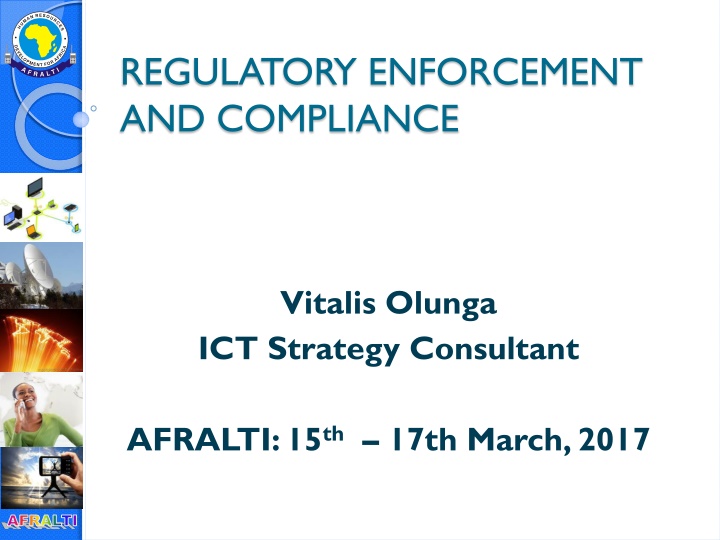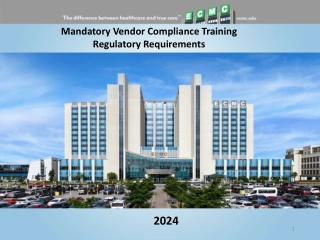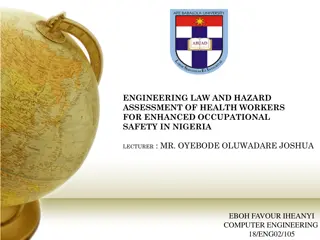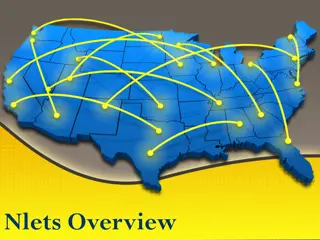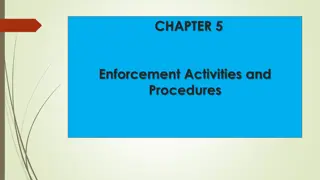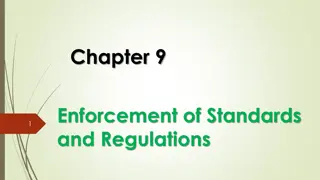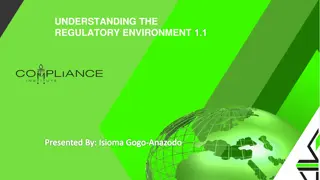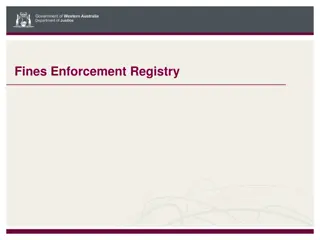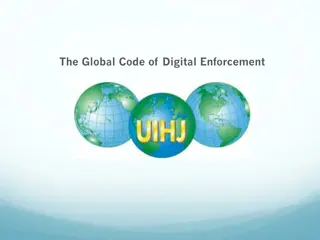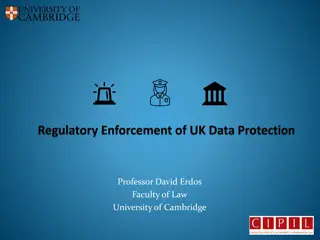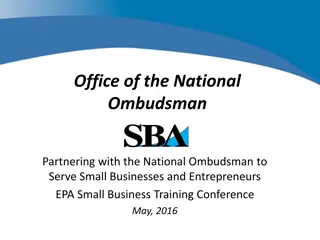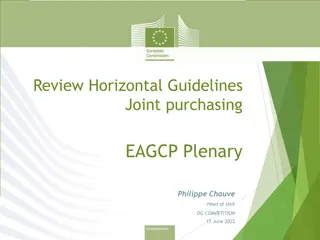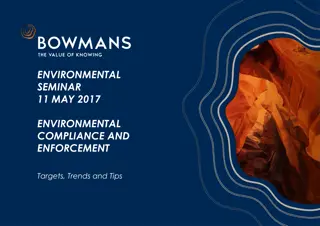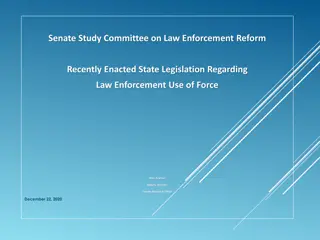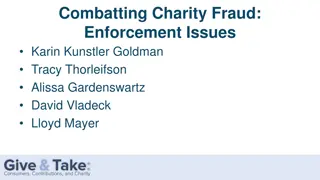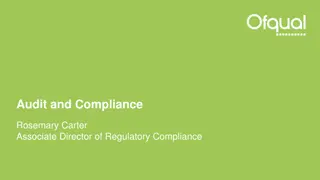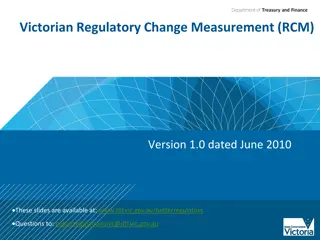Regulatory Enforcement and Compliance Overview
Oversight function in enforcing compliance with regulations and maintaining fairness in the telecommunications sector is crucial. Learn about legal instruments, monitoring quality of service, and regulatory tools for enforcement to ensure industry growth and protect consumers.
Download Presentation

Please find below an Image/Link to download the presentation.
The content on the website is provided AS IS for your information and personal use only. It may not be sold, licensed, or shared on other websites without obtaining consent from the author.If you encounter any issues during the download, it is possible that the publisher has removed the file from their server.
You are allowed to download the files provided on this website for personal or commercial use, subject to the condition that they are used lawfully. All files are the property of their respective owners.
The content on the website is provided AS IS for your information and personal use only. It may not be sold, licensed, or shared on other websites without obtaining consent from the author.
E N D
Presentation Transcript
REGULATORY ENFORCEMENT AND COMPLIANCE Vitalis Olunga ICT Strategy Consultant AFRALTI: 15th 17th March, 2017 AFRALTI
DAY 1 Overview: Oversight Function Why Enforce Compliance? Legal and Regulatory Instruments for Enforcing Compliance Quality of Service Monitoring and Compliance Regulatory Tools for QoS Enforcement AFRALTI 2
Oversight Function The oversight function consists of the regulator s ability to monitor the performance of telecommunications companies and ensure compliance with telecommunications regulation and other subordinate rules. To ensure the effectiveness and transparency of the oversight function, regulators must implement detailed subordinate guidelines such as dispute resolution and enforcement procedures. To ensure compliance and enforcement of regulations and license conditions, the regulator must have the authority to investigate the activities and company records of service providers when needed, and to impose penalties for violation of laws, regulations or license conditions. AFRALTI 3
Oversight Function This need is accentuated in markets transitioning to competition, as incumbents have clear incentives to delay the entry of such new market players to prolong their dominance. The regulator s oversight functions should include the power to request information from both public and private parties. The regulator may request telecommunications companies to provide information regarding items such as their financial records, customer contracts, and installed infrastructure. Regulations regarding monitoring and enforcement include: procedures for investigating violations, determining fault standards, imposing penalties, requesting the regulator s review of enforcement decisions, and submitting appeals to the regulator , tribunal or to the courts. AFRALTI 4
Why enforce compliance? To maintain order in the sector Maintain stability in the sector Ensure growth and development in the sector Protect consumers and industry players Promote fair and effective competition AFRALTI 5
CA Legal & Regulatory Instruments for enforcing compliance Sector laws (KICA 1998) Sector Regulations (2001, 2009, 2010, 2013 etc) as amended Regulatory Directives Regulatory determinations License conditions Consumer Protection Act, 2012 AFRALTI 6
CA Documents for Enforcing Compliance Procedures to make a complaint regarding communication equipment or services Consumer Complaint Form Consumer Education Programme: Quality of Service Warranties Service Level Agreement Procedure related to handling Broadcast Content National Frequency Assignment Table Etc AFRALTI 7
Principles of Enforcement Fast-quick, decisive, clear to reduce uncertainty Firm- penalties MUST be severe enough to deter violations Fair- transparent, objective and evidence based decisions Flexible-have alternative enforcement mechanisms such as dispute resolution Consistency: regulator must be consistent to earn trust. regulator must abide by its decisions however unpopular AFRALTI 8
Areas of Enforcement Violations of the KICA 1998 Violations of regulations on Type approval QoS/QoE Competition Interconnection SIM card Registration Frequency Spectrum usage Broadcasting Breach of license conditions etc AFRALTI 9
Main stakeholders in enforcement ICT Operators/Service providers ICT Sector/Industry Consumers Regulators Law enforcement agencies Government Public AFRALTI 10
Resource requirements for effective enforcement Competent and committed staff Adequate finances Proper technical tools/instruments/gear Enabling power to enforce Management support AFRALTI 11
Enforcement procedures applicable in CA Record received/self investigated violation Notify the affected party and provide opportunity to respond Issue interim orders/sanctions Seize offending material/equipment Resort to court action against culprits AFRALTI 12
How a regulator detects a breach requiring enforcement Self initiation: Regulator/Licensee initiated Investigations Inspections Enquiries Measurements/monitoring Self- regulation by licensees Consumer initiated investigations: Consumer complaint Complaints (e.g. Chukua Hatua) Reports by individuals and consumer bodies Public complaint Industry complaint Technical monitoring (e.g. QoS, Frequency interference etc) AFRALTI 13
Important CA Regulations Type-approval Licensing & QoS Enforcement & compliance SIM Card Registration Competition Interconnection Spectrum Management AFRALTI 14
SIM Card Registration Regulation Very important-security threat ID Required No hawking of Sim Cards (Section 27 (b)(3) of the KIC(A)A 2013 Collaboration on National Level Operators to report to CA Sim Card Registration Status AFRALTI 15
Type approval Regulations All telecommunications equipment connected to telecoms system/network MUST be type-approved/accepted Safety of users Network integrity Comply with international/ITU/SDI standards for good QoE AFRALTI 16
Quality of Service Regulations QoS parameters developed by CA and MNO Every MNO to meet the set targets/thresholds Measurement done quarterly using state of the art equipment Severe penalties imposed on violators Both voice and data/sms QoS monitored AFRALTI 17
QoS Monitoring and Compliance /1 Monitoring of the Quality of Service (QoS) requires the setting up of the regulatory framework that would provide the basis for the ICT industry to maintain or improve the quality either in the presence or absence of competition. This also allows the ICT consumers to make informed choices in uptake of services. Recognition is given to the much work done by many ICT regulators in developing countries, publishing regulations on the monitoring of the quality of service, however, it is being noted that enforcement has been a challenge. AFRALTI 18
QoS Monitoring and Compliance /2 The innovation in ICT , particularly, transition to the packet switching networks has led to the revisiting of the methods used by regulators in monitoring of QoS. It is important to ensure that the existing regulations and methods used to monitor the QoS are aligned to the changes in the environment. The existing regulations are to be aligned to the evolving technologies and the standardization development, as led by ITU. AFRALTI 19
Fundamentals of Quality of Services Overall Network Operation; Telephone Service; Service Operation and; Human Factors AFRALTI 20
Quality of Service Regulation Quality of Service Regulation AFRALTI 21
CA QoS Perspective Quality of Service is the level of performance (or quality ) that a service provider provides to its subscribers. In telecommunications, this relates to the ability of a service provider to give reliable, accessible and easy to use services. The provider should also offer reliable and effective customer service Before a consumer purchases communications products or services, some aspects should be taken into consideration besides the price. AFRALTI 22
CA QoS Perspective Some service providers may at some point even limit the number of subscribers that they accept concurrently and not every service provider has an easy process for consumers to subscribe to their services. Consumers are also faced with the fact that the services that they subscribe to are sometimes not satisfactory for example, instances when the network is inaccessible making it impossible for one to make a phone call or when the call is disconnected during a conversation due to some fault of the network or when one cannot hear the other party on the phone. AFRALTI 23
CA QoS Perspective Consumers should be aware of the fact that some of the communication networks may lack the capacity to handle all traffic or simultaneous requests for services from the various users. In most cases applications with very different characteristics and requirements compete for scarce network resources. For such networks, where the capacity is a limited resource, the consumer cannot expect to always get the highest possible level of service but must accept a certain level of degradation. AFRALTI 24
CA QoS Perspective Consumers are entitled to the following basic levels of service; Value for money Accurate billing Ease of use of the service or product Professionalism, on the part of the service provider, in the provision of the service AFRALTI 25
CA QoS Perspective Flexibility in the use of the service on the part of the consumer for instance; the ease with which the consumer is able to switch from one operator to another; from one resource to another; one piece of equipment to another or even in the requirement for the change of a telephone number That the product or service should perform according to specified expectations That the service be reliable and fulfill the needs of the consumer as specified That the service be secure in terms of privacy of ALL data sent and received. AFRALTI 26
Fundamentals of Quality of Service Concept of Quality of Service Justifications for quality of service regulation Parameters and targets Activities in quality of service regulation AFRALTI 27
Concept of Quality of Service WHAT What is Quality? What is Service? What is Standard? WHO Who is interested in Quality? Who is responsible for Quality? Who is responsible for Standards? AFRALTI 28
Concept of Quality Quality of service is the "collective effect of service performance, which determines the degree of satisfaction of a user of the service" (ITU-T E.800). Quality of service regulation is part of customer protection, however, customer protection is broader than quality of service regulation Customer protection covers, sales activities, complaint resolution procedures and disconnection policies, etc. Quality of service is not the same as network performance, which is concerned not with user experience but with standards for network design. AFRALTI 29
Justification of QoS Regulations Quality of service regulation aims at: helping customers to make informed choices; checking claims by operators; understanding the state of the market; maintaining or improving quality in the presence or absence of competition; helping operators to achieve fair competition; making interconnected networks work well together. AFRALTI 30
Distinction among Quality Elements Quality of Service Network Performance Quality of Experience Customer Satisfaction AFRALTI 31
Definition of Quality of Service QoS is define as the totality of characteristics of a telecommunications service that bear on its ability to satisfy stated and implied needs of the user of the service (ITU T E.800). Characteristics is a property which helps to differentiate between the individuals of a given population. The differentiation may be either quantitative (by variables) or qualitative (by attributes) Characteristics should be observable and/or measurable. When defined, the characteristics become parameters and are expressed by metrics A metric measure is a unit by which a parameter may be expressed. Implied needs are the perceived QoS requirements AFRALTI 32
Customer QoS Requirements QoS requirements of user/customer (QoSR) A statement of QoS requirements by a customer/user or segment/s of customer/user population with unique performance requirements or needs. Stated needs are the QoS requirements of the user/customer The customer/user needs may be expressed in descriptive terms (criteria) listed in the order of priority, with preferred performance value for each criterion. The service provider translates performance values into parameters and metrics pertinent to the service (ITU-T E.802). AFRALTI 33
QoS Offered and QoS Delivered QoS Offered/Planned by service provider (QoSO) A statement of the level of quality planned and offered to the customer by the service provider. Level of QoS the service provider plans to achieve (and therefore offers) to the customer/user; Expressed by target values (or range) for measures of parameters pertinent to a specified service. QoS Delivered by Service Provider (QoD) A statement of the level of QoS achieved or delivered to the customer. The achieved or delivered QoS expressed by metrics for the pertinent parameters for a service. AFRALTI 34
Customer Experienced/Perceived QoSE A statement expressing the level of quality that customers/users believe they have experienced. The level of QoS experienced and/or perceived by the customer/user may be expressed by an opinion rating (OR). QoSE has two main components: The quantitative component influenced by the complete end-to- end system effects (network infrastructure). The qualitative component influenced by user expectations, ambient conditions, psychological factors, application context, etc. QoSE may also be considered as QoSD received and interpreted by a user with the pertinent qualitative factors influencing his/her perception of the service. AFRALTI 35
End-to-End QoS and Network Performance AFRALTI 36
End-to-End QoS QoS covers the whole end-to-end view of a telecommunications service and can be subdivided into separate parts that all have an influence on the resulting QoS. The degree of QoS depends on the collective effect of all sub-parts. The sub-parts include: User Equipment-Access Network-Core Network-Access Network- User Equipment [ITU-T E.804 and ITU-T E.800]. AFRALTI 37
Fig.1: Schematic End-to-End QoS Terminal Equipment Access Network Core Network User Terminal Equipment Core Network Access Network User Source: ITU-T E. 800; The conventional service configuration with users at each end of a connection. The principle may apply to services by a service provider at one end and user/s at the other end. AFRALTI 38
Fig. 3 : Relationship between QoS and Network Performance(NP) Quality of Service Non-Network Performance Network Performance Source: ITU-T E.800 QoS comprises both network performance and non-network related performance AFRALTI 39
Network and Non-Network Performance Network Performance Measures Bit error rate, Latency, Through-put (speed), Etc Non-network performance measures: Provision time Time to repair Range of tariffs Complaints resolution time, Etc AFRALTI 40
Network Performance (NP) NP is the ability of a network or a portion of a network to provide the functions related to communications between users [ITU-T E.800]. NP applies to the network provider's planning, development, operations and maintenance activities NP is the detailed technical part of QoSO a technical way of assessing technical parameters which describe the performance part of the network in a desired way (ITU-T E.804). The NP is assessed across a part of a network or a sub-network [Access Network or Core Network] Overall NP is from UNI to UNI: Access Network-Core Network- Access Network with several network sections considered as being one integral part of the network ("black box"). NP parameters are meaningful to network providers and are quantifiable at the part of the network which they apply. AFRALTI 41
Fig. 2: End-to-End QoS Terminal Equipment Access Network Core Network Access Network Terminal Equipment User User NP NP NP Overall NP (UNI-UNI) End-to-End Quality of Service Quality of Experience Source: ITU-T E. 804 AFRALTI 42
End-to-End QoS User: An individual or organization using or requesting publicly available telecommunications services. Terminal Equipment: Variability of the performance of terminal equipment Access Network: Combination of access medium and technology used for a particular service (e.g. wireless, cable, ADSL) Core Network: Configurations of network components Single provider: National telecommunication services Multiple providers: National services; International services Technology used: digital multiplexing, IP, etc Transmission media: Air:- terrestrial microwave radio radios, cellular mobile, Wi-Fi, WiMaX, satellite, etc ; Cable: optical fibre, coaxial, twisted wireline AFRALTI 43
QoSE Components QoSE has two main components: quantitative and qualitative. The quantitative component: Influenced by the complete end-to-end system effects (network infrastructure). The qualitative component: Influenced by user expectations, ambient conditions, psychological factors, application context, etc. QoSE may also be considered as QoSD received and interpreted by a user with the pertinent qualitative factors influencing his/her perception of the service. AFRALTI 44
NP Versus QoS (ITU-T I.350) Network Performance Quality of Service Provider Oriented Connection Element Attribute Focus on planning, development(design), operations and maintenance End to End or Network Connection Element capabilities User Oriented Service Attribute Focus on user observable effects Between (or at) Service access points AFRALTI 45
Quality of Experience (QoE) The QoE includes: User-User Equipment-Access Network-Core Network-Access Network- User Equipment-User (ITU-T E.804] The inclusion of the user to the overall quality in telecommunications extends the rather objective QoS to the highly subjective quality of experience (QoE). The QoE differs from user to user since it is influenced by personal experiences and expectations of the individual user. AFRALTI 46
AFRALTI 47
Non-Network Performance Measures Complaint A statement by a user or customer expressing dissatisfaction due to a gap between the expected and the delivered benefits from the use of a service. A complaint may be made in various forms, writing, electronic means, or in person. Directory services A service to search and retrieve information from a catalogue of well-defined objects, which may contain information about certificates, telephone numbers, access conditions, addresses, etc. An example is provided by a directory service conforming to ITU-T X.500, ITU-T X.843. AFRALTI 48
Customer Satisfaction Customer: The party that uses a telecommunication service(s) under a contractual agreement. A user who is responsible for payment for the services [ITU-T E.800]. AFRALTI 49
Factors Influencing Customer Satisfaction Technical Quality of the service delivered by the service provider Network Performance Terminal Performance Billing Accuracy After sale technical support Non-Technical Customer care Point of Sale Pricing Complaint handing Pricing AFRALTI 50
